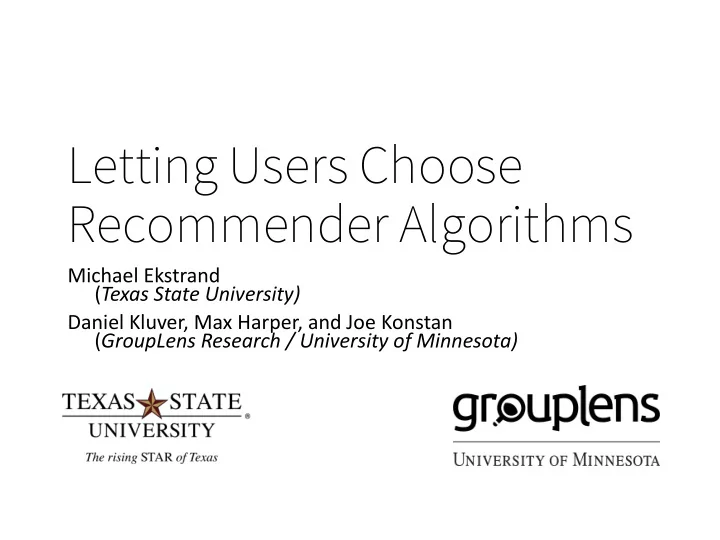

Letting Users Choose Recommender Algorithms Michael Ekstrand ( Texas State University) Daniel Kluver, Max Harper, and Joe Konstan ( GroupLens Research / University of Minnesota)
Research Objective If we give users control over the algorithm providing their recommendations, what happens?
Why User Control? • Different users, different needs/wants • Allow users to personalize the recommendation experience to their needs and preferences. • Transparency and control may promote trust
Research Questions • Do users make use of a switching feature? • How much do they use it? • What algorithms do they settle on? • Do algorithm or user properties predict choice?
Relation to Previous Work Paper you just saw: tweak algorithm output We change the whole algorithm Previous study (RecSys 2014): what do users perceive to be different, and say they want? We see what their actions say they want
Outline 1. Introduction (just did that) 2. Experimental Setup 3. Findings 4. Conclusion & Future Work
Context: MovieLens • Let MovieLens users switch between algorithms • Algorithm produces: • Recommendations (in sort-by-recommended mode) • Predictions (everywhere) • Change is persistent until next tweak • Switcher integrated into top menu
Algorithms • Four algorithms • Peasant: personalized (user-item) mean rating • Bard: group-based recommender (Chang et al. CSCW 2015) • Warrior: item-item CF • Wizard: FunkSVD CF • Each modified with 10% blend of popularity rank for top-N recommendation
Experiment Design • Only consider established users • Each user randomly assigned an initial algorithm (not the Bard) • Allow users to change algorithms • Interstitial highlighted feature on first login • Log interactions
Users Switch Algorithms • 3005 total users • 25% (748) switched at least once • 72.1% of switchers (539) settled on different algorithm Finding 1: Users do use the control
Ok, so how do they switch? • Many times or just a few? • Repeatedly throughout their use, or find an algorithm and stick with it?
Switching Behavior: Few Times Transition Count Histogram 250 196 200 157 150 118 100 63 54 50 32 22 21 12 12 11 7 5 4 4 4 3 2 1 0 1 2 3 4 5 6 7 8 9 10 11 12 13 14 15 16 17 18 19 # of Transitions
Switching Beh.: Few Sessions • Break sessions at 60 mins of inactivity • 63% only switched in 1 session, 81% in 2 sessions • 44% only switched in 1 st session • Few intervening events (switches concentrated) Finding 2: users use the menu some, then leave it alone
I’ll just stay here… Question: do users find some algorithms more initially satisfactory than others?
Frac. of Users Switching (all diffs. significant, χ 2 p<0.05) 35.00% 30.00% 29.69% 25.00% 22.07% 20.00% 17.67% 15.00% 10.00% 5.00% 0.00% Baseline Item-Item SVD Initial Algorithm
…or go over there… Question: do users tend to find some algorithms more finally satisfactory than others?
…by some path What do users do between initial and final? • As stated, not many flips • Most common: change to other personalized, maybe change back (A -> B, A -> B -> A) • Users starting w/ baseline usually tried one or both personalized algorithms
Final Choice of Algorithm (for users who tried menu) 400 350 341 300 292 250 200 150 100 50 62 53 0 Baseline Group Item-Item SVD
Algorithm Preferences • Users prefer personalized (more likely to stay initially or finally) • Small preference of SVD over item-item • Caveat: algorithm naming may confound
Interlude: Offline Experiment • For each user: • Discarded all ratings after starting experiment • Use 5 most recent pre-experiment ratings for testing • Train recommenders • Measure: • RMSE for test ratings • Boolean recall: is a rated move in first 24 recs? • Diversity (intra-list similarity over tag genome) • Mean pop. rank of 24-item list • Why 24? Size of single page of MovieLens results
Algorithms Made Different Recs • Average of 53.8 unique items/user (out of 72 possible) • Baseline and Item-Item most different (Jaccard similarity) • Accuracy is another story…
Algorithm Accuracy RMSE Boolean Recall 0.74 0.3 0.72 0.25 0.7 0.2 0.68 0.15 0.66 0.1 0.64 0.05 0.62 0 Baseline Item-Item SVD Baseline Item-Item SVD
Diversity and Popularity
Not Predicting User Preference • Algorithm properties do directly not predict user preference, or whether they will switch • Little ability to predict user behavior overall • If user starts with baseline, diverse baseline recs increase likelihood of trying another algorithm • If user starts w/ item-item, novel baseline recs increase likelihood of trying • No other significant effects found • Basic user properties do not predict behavior
What does this mean? • Users take advantage of the feature • Users experiment a little bit, then leave it alone • Observed preference for personalized recs, especially SVD • Impact on long-term user satisfaction unknown
Future Work • Disentangle preference and naming • More domains • Understand impact on long-term user satisfaction and retention
Questions? This work was supported by the National Science Foundation under grants IIS 08-08692 and 10-17697.
Recommend
More recommend